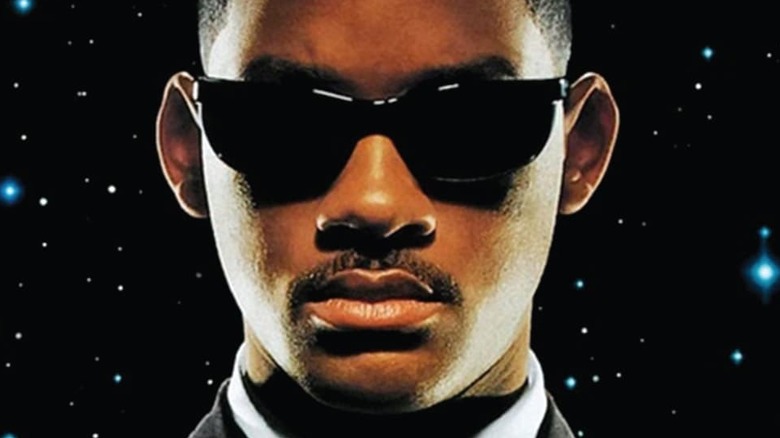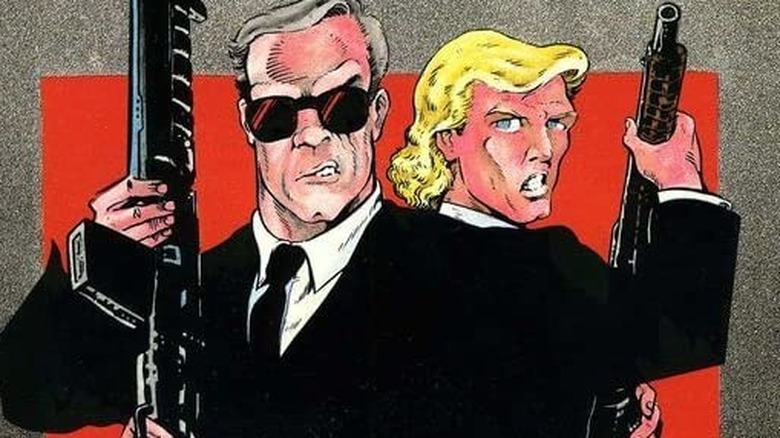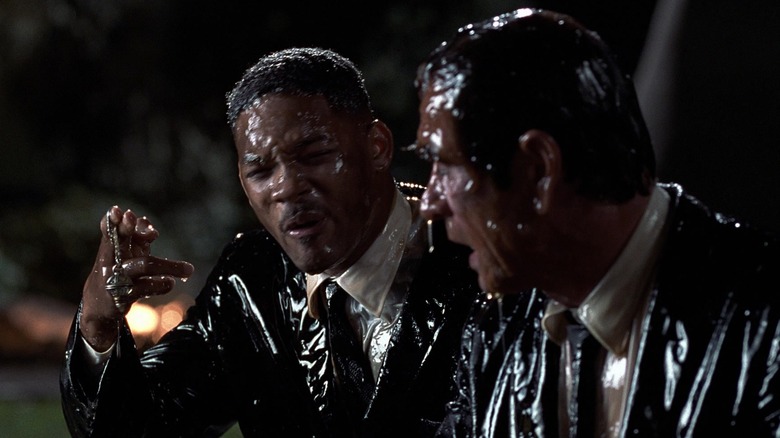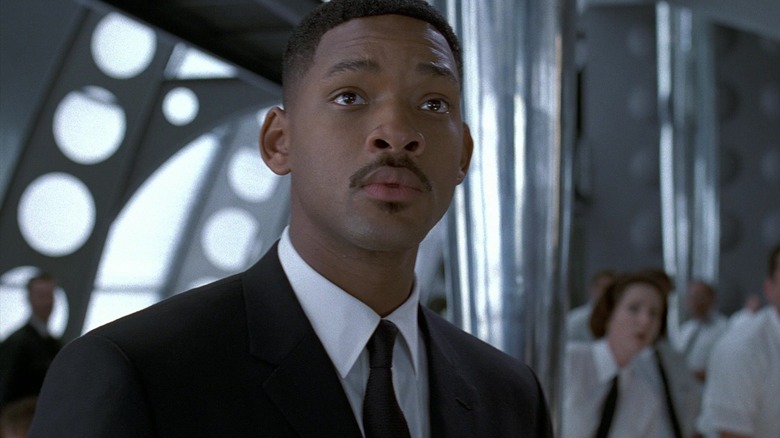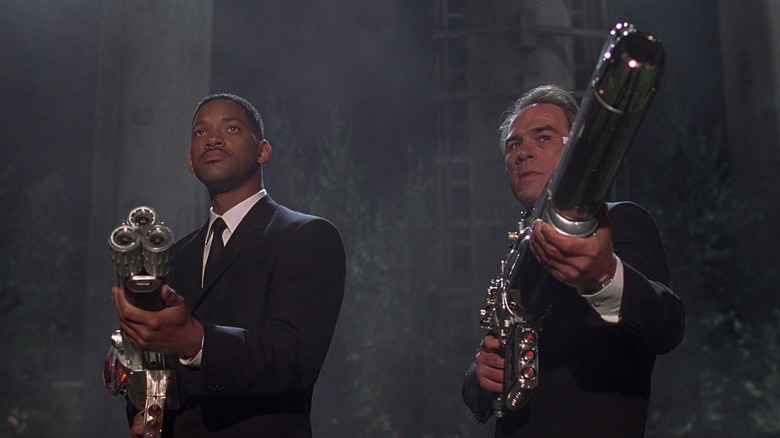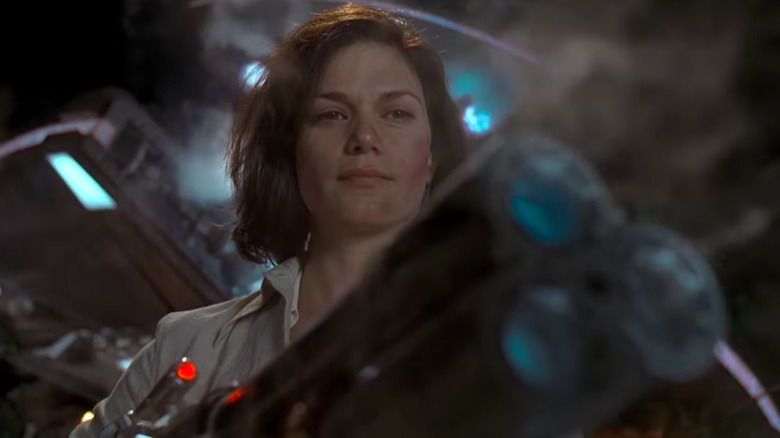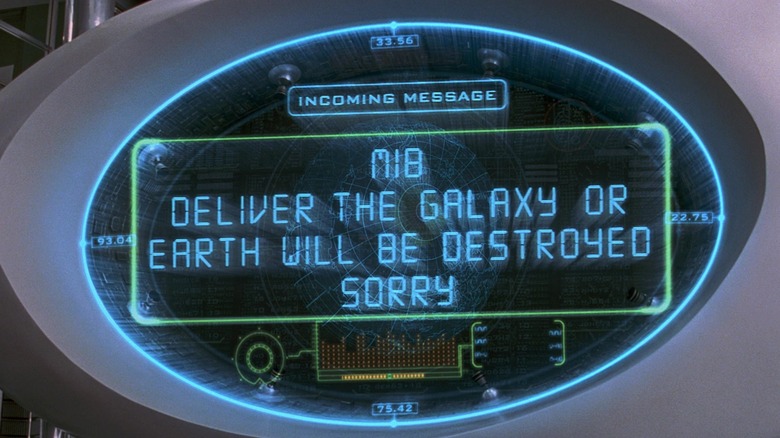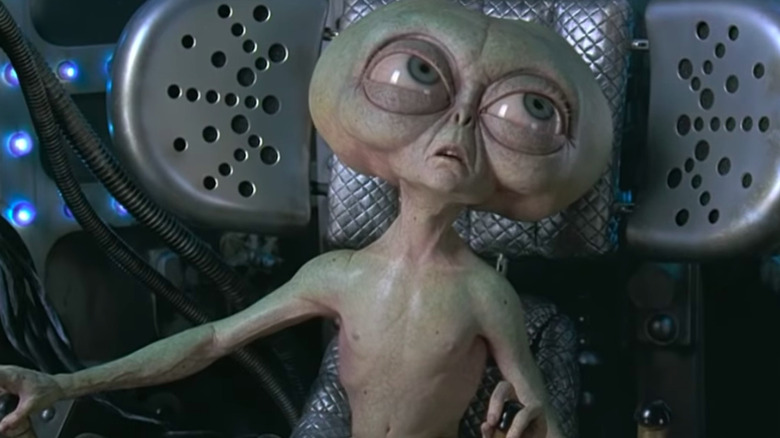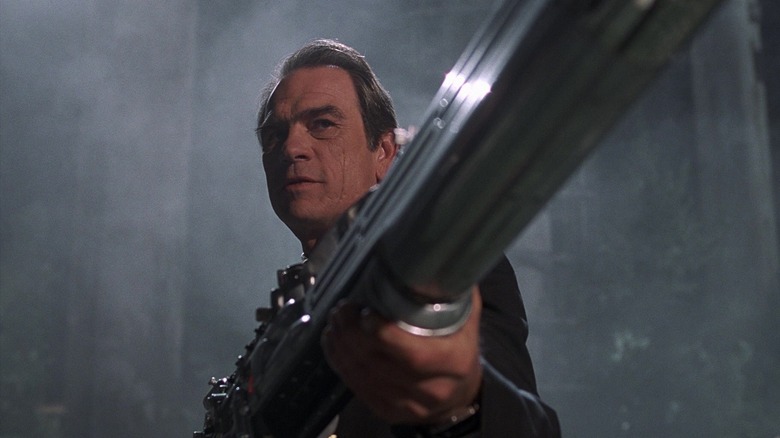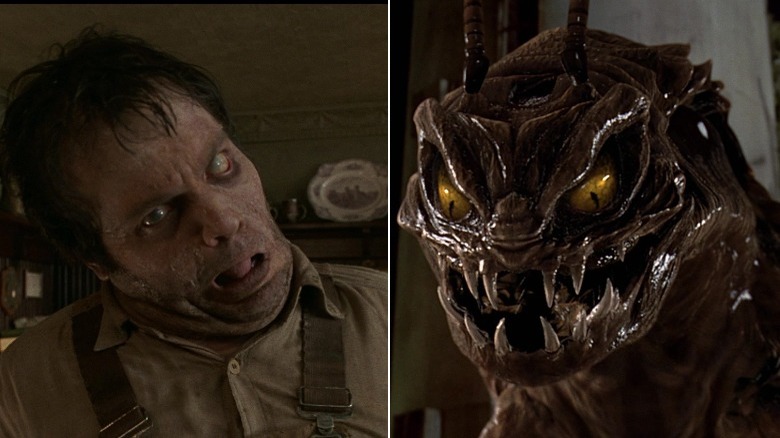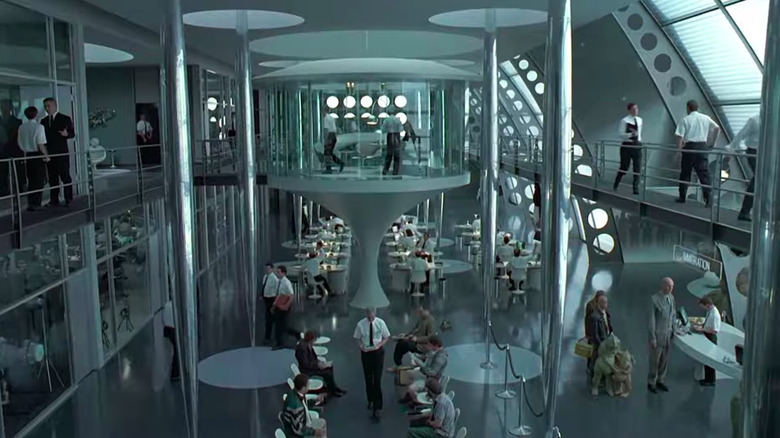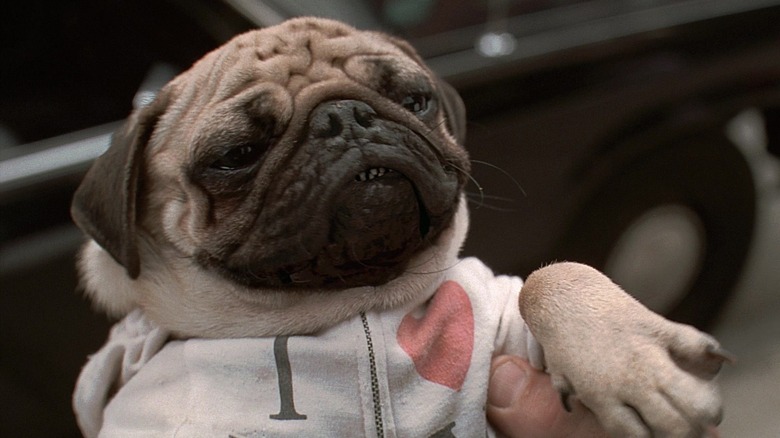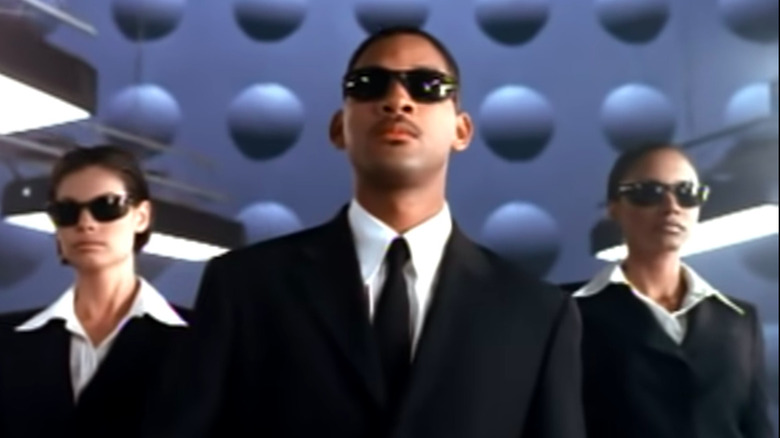The Untold Truth Of Men In Black
It's been 25 years since Will Smith's Agent J first donned the last suit he'd ever wear and one thing holds true: he, K, L and the gang still make being members of the Men in Black look good. In a summer with huge competition from surprise classics like "My Best Friend's Wedding," animated heavyweights like "Hercules" and blockbuster sequels like "The Lost World: Jurassic Park" and "Batman and Robin," the first "Men in Black" movie (starring Smith, Tommy Lee Jones and Linda Fiorentino) beat the odds and became the top grossing film of the year domestically: an amazing success no neuralyzer can wipe from box office history. On top of that, the film spawned two sequels, one spin-off ("Men in Black: International") and a well-regarded animated series, as well as a number of video games based off the film and the cartoon.
With "Men in Black" having briefly returned to theaters on July 3 and 4, 2022, with an eye-popping 4K remaster that hits stores July 19 (don't take the "eye-popping" part too seriously, alien readers from Centauri B), it seems like the perfect opportunity to dig up some little-known facts about our first line of defense against the scum of the universe. Pull out your Ray-Bans and get ready to learn about the surprising origins of the "Men in Black" franchise, as well as plenty of other factoids a certain alien-policing organization might not want you to know about.
The Marvel Comics adaptation you didn't know about
Despite the opening credits stating that "Men in Black" is "based on the Marvel Comic by Lowell Cunningham," it's still easy to miss that fact, given the obscurity of the three-issue comic series that started it all. "The Men in Black," in fact, wasn't actually published by Marvel originally, but instead a small company called Aircel Comics. Still, its influence on the film is undeniable, as the comic introduces the franchise's core concept and familiar characters like J and K — spelled "Jay" and Kay," like in the film's credits — as well as Zed, though he never appears in person. Specifically, the movie loosely adapts issue #2 of the comic, which also features an alien bug encountering a farmer, as well as elements of #1, including Jay's recruitment to the MIB.
There are undeniable similarities, including certain lines, scenes and even, to an extent, the trademark humor. Yet there are also differences: aside from how different Kay and Jay look physically, Agent L is nowhere in sight, and the Bug is far more benevolent than he is in the film. Agent Kay, conversely, is more bloodthirsty, and his moral clashes with the more diplomatic Jay is at the heart of the comic series. Furthermore, the comic book MIB deal with more than just aliens, and only use outlandish weaponry for special missions — except for the neuralyzer (spelled "neurolyser"), which controls minds (although it can still make people forget things).
The secret to the comedy
There's no denying that the first "Men in Black" film in particular is a riot. From Agent J's mishaps with the Noisy Cricket and tentacled aliens to Agent K's calm in even the most outlandish situations, it's hard not to at least crack a smile, let alone laugh out loud several times while watching the film. While there are plenty of chuckle-worthy lines, such as J's "I make this look good" and his trash-talking of the Bug, the Men in Black movies' humor is primarily situational in the eyes of director Barry Sonnenfeld.
"The secret to the whole 'Men in Black' franchise is that no one can be funny in the movie," Sonnenfeld explained to BlackTree Media, adding, "Situations can be funny, but no actor should try to act as if they're in a comedy." He elaborated on this approach when speaking to Indie Film Hustle Talks, revealing that he'd often tell Jones to go against his instinct to be humorous: "You're going to be funny by doing nothing," Sonnenfeld recalled telling the actor. "You are the audience's point of view, you are the reaction shot. The reaction shot gets more laughs."
Casting Will Smith was Barry Sonnenfeld's wife's idea
Changing the ethnicity of a character when adapting a comic to film wasn't as common around the time "Men in Black" was made as it is in the present day. It did sometimes happen, such as when Billy Dee Williams was cast as Harvey Dent in 1989's "Batman." But even that decision was reversed when, coincidentally enough, the character was recast with Tommy Lee Jones when Dent appeared as Two-Face in "Batman Forever." Suffice to say, casting Will Smith as Agent J, a blonde, white man in the comics, was a comparatively novel idea for the period.
Yet director Sonnenfeld knew Smith was the right choice, but not because he was familiar with Smith's work. The actor was recommended to Sonnenfeld by none other than Sonnenfeld's wife, Susan Ringo. She immediately suggested Smith play J after reading the script, based on his performance on "The Fresh Prince of Bel-Air." Despite Ringo's well-placed faith in Smith, however, the actor nearly turned down the role, fearing that starring in another alien-themed movie so soon after 1996's "Independence Day" would pigeonhole his career. Luckily, Smith, as he reveals on his YouTube channel, was talked into reconsidering by none other then mega-film director (and "Men in Black" co-producer) Steven Spielberg, who convinced him that the role, much like the cool uniform that came with it, were the right fit.
The actors who almost played Agents K and J
As far as Barry Sonnenfeld and Susan Ringo were concerned, Tommy Lee Jones and Will Smith were the right actors for K and J from the start. However, Sonnenfeld explained that the studios involved in making the film, along with Spielberg, had other ideas about who would don the black suits and shades. Their top Agent K candidate was Clint Eastwood, known even then for his talent at both directing and playing no-nonsense characters. Yet the Man with No Name would ultimately decide to not become a Man in Black after all, as David Hughes' "Comic Book Movies" elucidates, leaving the door open for Jones to play K as Sonnenfeld had hoped.
Conversely, quite a few actors were considered to bring Agent J to life. Among them was David Schwimmer of "Friends" fame, who told the Hollywood Reporter (via Den of Geek) that he opted instead to direct his first movie, and Jones' fellow "Batman Forever" alum Chris O'Donnell, whose star seemed on the rise after the massive success of said Bat-film two years earlier. Yet the man who played Robin ultimately did not trade the cape and Batarangs for sunglasses and a Noisy Cricket, unconvinced by the script's first iteration and enticed by a film offer from Sylvester Stallone. Not to mention that, as Sonnenfeld comically confessed to Indie Film Hustle, he also subtly talked O'Donnell out of the role so that Smith could claim it instead.
Linda Fiorentino was cast thanks to a poker game
While a sizable chunk of the original "Men in Black" movie centers on Agent K's tutelage of Agent J, a third potent presence soon enters the picture in the form of coroner Dr. Laurel Weaver. Her shrewd deduction skills and knack for quickly getting the hang of high-tech weaponry she's unfamiliar with earn her a place among the MIB as Agent L ("Elle") once K departs the organization.
While the "L" is clearly meant to stand for Fiorentino's character's first name, it might as well also stand for "luck," given how Fiorentino claims to have landed the role. As she told Bobbie Wygant, it allegedly came down to a poker match between herself and director Barry Sonnenfeld, who supposedly offered her the part in addition to a cool $500 ... both of which Fiorentino ended up winning. Sonnenfeld contested the story somewhat when speaking to Insider, however, asserting that while he had been inspired to consider Fiorentino for L after the two had indeed played poker together, the role had not been offered as part of the pot. Either way, whatever good fortune Fiorentino brought to that game may have rubbed off on the character: She doesn't even become Agent L in an early script draft, as her memories of all things MIB-related are instead erased (again) after the film's main villain, the Bug, is defeated.
The script and story were always evolving
Rewrites aren't uncommon in Hollywood, but "Men in Black" in particular was under constant revision. Chris O'Donnell was not the only one with misgivings about the script in its earliest stages: "Comic Book Movies" points out that it would have also been a no-go for Tommy Lee Jones had changes not been made. Luckily, Sonnenfeld told Insider that the next draft won Jones over. But that didn't mean Jones was 100% satisfied at first, which he wasn't afraid to express to the film's screenwriter, Ed Solomon (of "Bill and Ted" fame). Fortunately, Solomon had no problem with revising the script and letting others do the same, noting on Twitter that Jones himself improved one scene in particular by using a facial gesture as a substitute for several lines of dialogue.
The refining of the film's script ultimately became a very collaborative experience, involving improvisations from Smith, dialogue suggestions Sonnenfeld made on set, and larger revisions the director requested from Solomon, such as changing most of the story's location to New York and taking more inspiration from "The French Connection." Major adjustments to the movie even went as deep as the editing process, with Sonnenfeld explaining to Ain't It Cool News how just a few clever visual and audio modifications allowed him to make drastic alterations. Those included, as visual effects supervisor Eric Brevig told VFXBlog, almost completely removing an alien species that had previously been crucial (albeit confusing) to the story.
Some of your favorite aliens almost weren't in the film
Just as one species, the Baltians, were largely exorcised (although "Men in Black: The Official Visual Companion to the Films" notes that the alien in a photograph that Agent K shows J is a Baltian), quite a few were added in — but not always by the movie's writer or editor. Among them, as special makeup effects artist Rick Baker told Movieweb, were the coffee-loving Worm Guys. Created by sculptor Aaron Sims, they had no specific place in the movie until a roboticist working on the film, Mark Setrakian, showed Sonnenfeld a clip of the aliens in a coffee break room created by mechanic Jurgen Heimann, who also helped turn the Worm Guys into puppets.
Furthermore, Gentle Rosenberg — the tiny Arquillian prince controlling a robot from within its head — didn't exist in the movie at all until Setrakian thought him up, as he told The Verge. Not only did "Mr. Gentle," or, as the crew often called him, "Chucky," become a pivotal character by revealing where he'd hidden his home galaxy (does the name "Orion's belt" ring a bell?), but Setrakian himself performed the dialogue for his own creation.
The stars loved the props, too
Just as memorable as the aliens and the performances in "Men in Black" are the uniquely designed weapons and paraphernalia, not to mention a really cool transforming car. While none of the sci-fi devices were real, of course, many would light up, just as a toy would, as Tommy Lee Jones explained to Bobbie Wygant – and the cast couldn't resist playing with them, Jones included. As Sonnenfeld related to Indie Film Hustle, Jones would often reflexively make laser gun sounds with his mouth when the film script had Agent K fire a weapon, and would unintentionally break the MIB's memory-erasing devices, the neuralyzers, by playing with the props too much.
Will Smith, naturally, also got quite a kick out of the film's props, admitting to Mark Greczmiel that Agent J's signature tiny gun with a kick, the Noisy Cricket, was his one souvenir from the set of the film.
How Edgar came to life
Edgar isn't the real villain of "Men in Black." He's just who the Bug, the film's true antagonist, poses as to more or less pass off as human. The Bug, however, only reveals its true form in the film's final battle, meaning he mostly appears as "Edgar" (a.k.a. "Edgarbug"), played impeccably by character actor Vincent D'Onofrio. To truly sell the idea that a gigantic bug had squeezed itself into Edgar's skin, D'Onofrio told Vulture that he used knee and ankle basketball braces early on in the shooting to inhibit his movements, so that it'd really look as if a much larger body was cramped within his own. To give Edgarbug his unique voice, D'Onofrio looked to the gravelly tones of famed actor George C. Scott, which he combined with an impression of movie powerhouse John Huston.
While much of Edgar's traits come from D'Onofrio himself, special makeup effects artist Rick Baker was instrumental in completing the character's look. D'Onofrio and Sonnenfeld explained that prosthetics were attached to D'Onofrio's face to give the impression that it was truly boneless; Baker even glued part of D'Onofrio's face together to further give Edgar an ill-fitting quality. While Edgarbug's appearance was achieved through practical means, his true form is mostly CGI, thanks to a last minute decision to eschew the animatronic versions the crew created to accommodate story changes. Eric Brevig told VFXBlog, however, that the gut that K shoots his way out of was still practical.
MIB HQ was based on '60s decor and airport terminals
Ever look at the interior shots of MIB headquarters and say to yourself, "This looks like an airport I went to once?" If so, that's no coincidence. Bo Welch, the production designer of "Men in Black," told SyFy that he decided to essentially design "a terminal for aliens traveling intergalactically." As he elaborated in "The Official Visual Companion," the facility functioned much more as a transit and customs area for extraterrestrial visitors rather than a detective office, which is what it was originally meant to resemble. Judging by the first scene the headquarters appears in, which features aliens lugging around suitcases, loudspeaker announcements, and everyone seemingly on their way to get somewhere, it's pretty clear Welch had the right idea.
More specifically, Welch drew inspiration from designs circa the 1960s, which is when Agent K states that the MIB first encountered extraterrestrial life. Among those were the former TWA Terminal (now a hotel) designed by Eero Saarinen, as well as rounded shapes that were also meant to evoke flying saucers. And if you're wondering why there isn't a lot of color in the building, that too was an intentional choice, done specifically to direct the audience's attention more toward the locale's otherworldly occupants.
The allegedly lavish life of one Frank the Pug
One of the most hilarious characters in "Men in Black" is Frank the Pug, an alien posing as a small dog belonging to a locksmith. Frank surprises Agent J by proving he's far more talkative than his "owner," especially when K pries information out of him about Rosenberg and his mysterious final words about a galaxy in the possession of his cat, Orion.
While Frank seems to live a fairly modest lifestyle in the film, his onscreen canine actor, Mushu, got to enjoy all sorts of perks from being a movie star. According to a National Enquirer interview with Animal Actors of Hollywood's Cheryl Shawver, those included cozy hotel stays, Business Class travel and attending the premieres of his own films. His diet was also similarly luxurious by pug standards (alien or otherwise), including meat and water fresh from the bottle — no tap water for this furred actor. One wonders if Mushu's successor, who played Frank in "Men in Black: International" (where his original voice actor, Tim Blaney, returned to the role), also indulged in such cozy amenities.
The real singer behind the Men in Black theme's chorus
It wasn't just the film that blew viewers away in 1997. Will Smith's song for the movie, also titled "Men in Black," was just as much of a hit, earning Smith a win the following year at the 40th Grammy Awards for Best Rap Solo Performance. That's pretty spectacular for what "The Official Visual Companion" notes was Smith's debut solo single (but far from his first hit or Grammy, as he'd obtained plenty of both while collaborating with Dj Jazzy Jeff). Meanwhile, the music video that accompanied the song nearly snagged itself an MTV Music Award and is notable for many reasons, including its faithfulness to the film, its enormous cost (a whopping $1 million, according to The Hollywood Reporter) and the apparent return of Mikey, an alien Agent K kills in the movie's opening scene.
While Smith performs the majority of the song, the chorus is sung by someone else — and it's not the two female MIB agents mouthing the words, or even "Mikey," who briefly sings with the same voice. As it turns out, the person behind the refrain is Cheryl Gamble, a.k.a. Coko of SWV, who also revealed to KevOnStage and DoBoy that she was unable to obtain permission to physically appear in the video. It would have been great to see her and Smith team up on screen ... although a singing and dancing alien was a pretty cool alternative.
